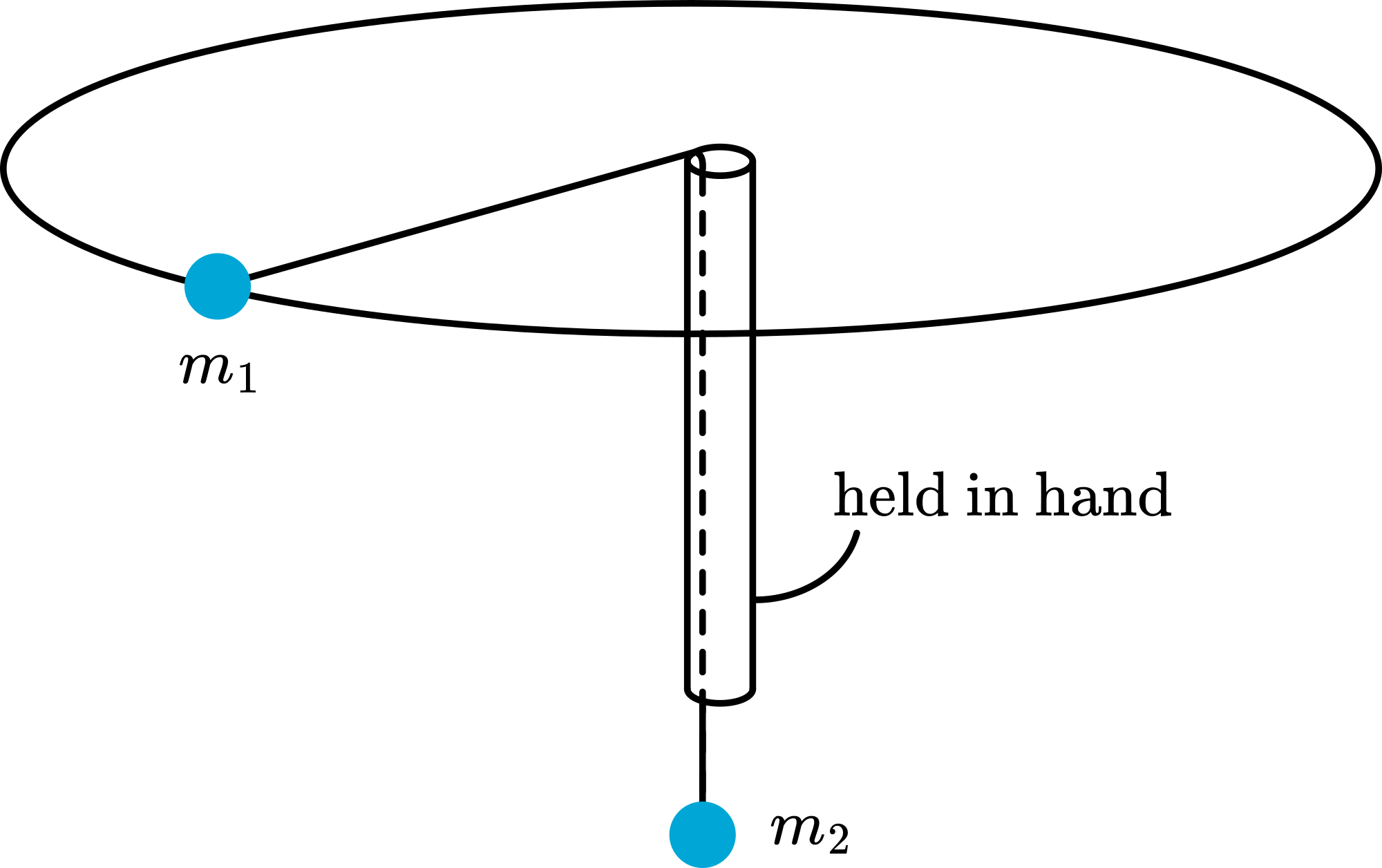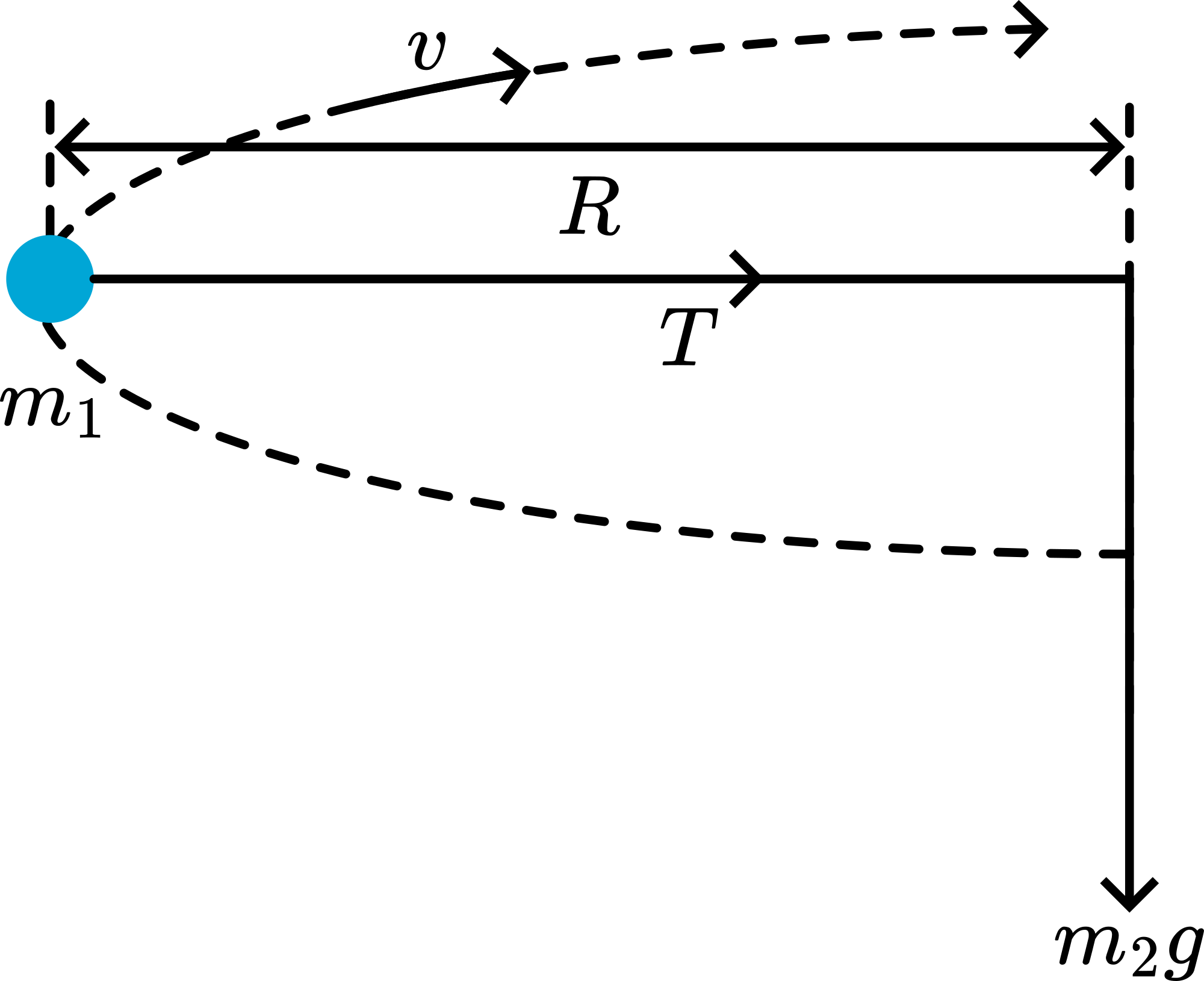01 Going Round in Circles#
Aim#
To see/feel the centripetal force.
Subjects#
1D50 Central Forces
Diagram#

Fig. 21 .#
Equipment#
Tube, with rounded edges, \(l=15 \mathrm{~cm}\).
Piece of rope, \(l=1.5 \mathrm{~m}\).
Two rubber stoppers \(\left(m_{1}\right)\).
A number of weights \(\left(m_{2}\right)\). We use thick washers.
Paperclip.
(Stopwatch).
Presentation#
The diagram shows the components and how to use them. By swinging the tube slightly, the mass \(m_{1}\) begins to move in circles above your head. The demonstrator must swing \(m_{1}\) at a specific frequency to balance the system.

Fig. 22 .#
When the demonstrator slows down to a lower frequency, \(m_2\) moves downward, causing \(m_1\)’s circular path to become smaller and smaller. Speeding up causes \(m_2\) to rise, and $\(m_1\)$ moves in increasingly larger circles.
The demonstrator first swings \(m_1\) in a stable circular motion. Then, by pulling \(m_2\) downward, \( m_1\) speeds up dramatically, tracing tighter and tighter circles.
If time permits, the relationship between the variables in this demonstration can be verified more exactly. Just below the tubing, a paperclip is fixed to the rope used as a marker to make \(m_{1}\) go round in a circle with fixed \(R\). A stopwatch can be used to time the frequency.
When \(m_1\) is doubled by adding another rubber stopper to it, a lower frequency is needed to balance the system.
When \(m_{2}\) is increased, a higher frequency is needed to balance the system.
When half the rope length is used (shifting the paperclip), a higher frequency is needed to balance the system.
Explanation#
Analysis shows that movement at a constant speed ( \(v\) ) of a mass ( \(m_{1}\) ) in a circle with radius \(R\) can be described by \(a_{c}=\frac{v^{2}}{r} \omega^{2} R\). In our demonstration the tension ( \(T\) ) in the string provides the force needed for \(a_{c}: T=m_{1} a_{c}\), and \(m_{2} g=m_{1} a_{c} \Rightarrow a_{c}=\frac{m_{2}}{m_{1}} g\), (see Figure 23).

Fig. 23 .#
First, the demonstrator showed a balanced situation, after which he slowed down \(\omega\). The centripetal acceleration, describing such a slower movement, will be lower \(\left(a_{c}=\omega^{2} R\right)\). But \(T\) is a fixed value, so \(T\) will pull \(m_{1}\) inwardly. As \(a_{c}=\omega^{2} R\) shows, this proces is cumulative and \(m_{1}\) ends at the centre of the circle.
When \(m_2\) is pulled downward, the string tension increases substantially, and so does \(a_c\). According to \(a_c = \omega^2 R\), and given that \(R\) decreases, \(\omega\) increases significantly.
Doubling \(m_1\) means that the centripetal acceleration \(a_c\) provided by the string tension will be halved \(\left(a_c = \frac{m_2}{m_1} g\right)\). To keep \(m_1\) moving in the same circle, \(\omega\) must decrease by a factor of \(\sqrt{2}\) according to \(\left(a_c = \omega^2 R\right)\).
Increasing \(m_2\) raises the string tension, so the provided \(a_c\) increases \(\left(T = m_1 a_c\right)\). To keep \(m_1\) moving in the same circle, \(\omega\) has to increase.
When \(R\) is halved but the tension in the string remains the same, the provided \(a_c\) also remains constant. To keep \(m_1\) moving in a (smaller) circle, \(\omega\) must increase by a factor of \(\sqrt{2}\) according to \(\left(a_c = \omega^2 R\right)\).
Remarks#
Practice the demonstration before you show it. A practiced hand is needed to make \(m_1\) go round properly.
Rubber stoppers are used as masses moving in circles for safety reasons.
The spinning mass should be light compared to the hanging weight (about a factor of 3), because otherwise the angle between the string and the vertical will not approach \(90^\circ\). This leads to more friction, and due to the slanting rope (forming a cone around the circle), the analysis changes.
In the last part of the presentation (grabbing and pulling \(m_2\) downward), the demonstrator will feel that quite a lot of force is needed. It is, of course, most instructive for the students if they experience this force themselves (perhaps during the coffee break?).
Sources#
Ehrlich, Robert, Turning the World Inside Out and 174 Other Simple Physics Demonstrations, pag. 72-73
Mansfield, M and O’Sullivan, C., Understanding physics, pag. 68-71 and74-75
